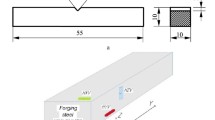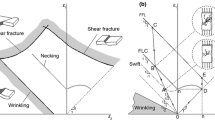Abstract
The “essential work of fracture” (EWF) method is applied to various machine-made papers. The deforming and fracturing processes of the paper samples during testing is analyzed by means of the thermographic observation. Plastic deformation zone appears in three ways when deep double edge notched tension specimens are strained under in-plane stress: i.e. 1. type (i)--appearing through whole the ligament in a vague manner and developing into a circular (or oval) zone even before or at the maximum load point; 2. type (ii)--appearing from notch tip and amalgamating into a circular (or oval) zone after the maximum load point; and 3. type (iii)--appearing from notch tip and not amalgamating into a circular (or oval) zone until the sheet failure. Specimens with small ligament length (L) are likely to belong to type (i), while those with large L to type (ii) & (iii). Among these three types, type (i) fulfills the original assumption of the EWF method best in terms of the complete ligament yielding before crack initiation. Thus the specific essential work of fracture determined using the linear relation of type (i) should be correct, although the estimated work is a little smaller than that from the linear relation of type (ii) & (iii).
Similar content being viewed by others
References
K. Niskanen, in "Products of Papermaking," edited by C. F. Baker (PIRA International, Leatherhead, Surry, UK., 1993) p. 641. Transactions of the 10th Fundamental Research Symposium, Oxford, September 1993.
T. Yuhara and M. T. Kortschot, ibid., p. 783.
R. S. Seth, ibid., p. 1529.
C. Fellers, "Lorentzen & Wettre Handbook-95" (Lorentzen & Wettre, Sweden, 1995) p. 100.
A. Tanaka, Y. Otsuka and T. Yamauchi, Tappi J. 80 (1997) 222.
R. S. Seth, A. G. Robertson, Y. W. Mai and J. D. Hoffman, ibid. 76 (1993) 109.
R. S. Seth, ibid. 78 (1995) 177.
B. Cotterell and J. K. Reddel, Int. J. Fract. 13 (1977) 267.
B. Cotterell, in "Fracture Mechanics and Technology, Vol. 2," edited by G. C. Sih and C. L. Chow (Sijthoff and Nordhoff, Alphenaan den Rijn, 1977) p. 785.
Y. Yu and P. KÄrenlampi, J. Mater. Sci. 32 (1997) 6513.
Author information
Authors and Affiliations
Rights and permissions
About this article
Cite this article
Tanaka, A., Yamauchi, T. Deformation and fracture of paper during the in-plane fracture toughness testing--Examination of the essential work of fracture method. Journal of Materials Science 35, 1827–1833 (2000). https://doi.org/10.1023/A:1004797023064
Issue Date:
DOI: https://doi.org/10.1023/A:1004797023064




